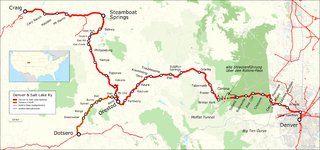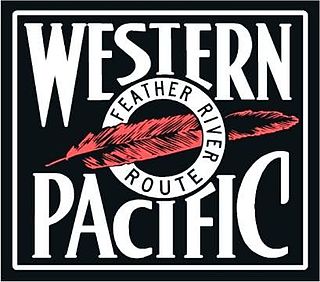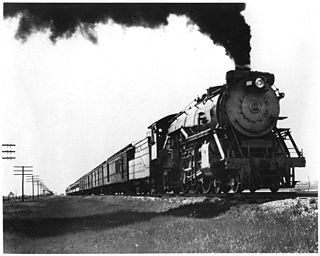
The Denver & Rio Grande Western Railroad, often shortened to Rio Grande, D&RG or D&RGW, formerly the Denver & Rio Grande Railroad, was an American Class I railroad company. The railroad started as a 3 ft narrow-gauge line running south from Denver, Colorado, in 1870. It served mainly as a transcontinental bridge line between Denver, and Salt Lake City, Utah. The Rio Grande was also a major origin of coal and mineral traffic.

The City of Cañon City is a Home Rule Municipality that is the county seat and the most populous municipality of Fremont County, Colorado, United States. Cañon City is the principal city of the Cañon City, CO Micropolitan Statistical Area and is a part of the Front Range Urban Corridor. The city population was 16,400 at the 2010 United States Census. Cañon City straddles the easterly flowing Arkansas River and is a popular tourist destination for sightseeing, whitewater rafting, and rock climbing. The city is known for its many public parks, fossil discoveries, Skyline Drive, The Royal Gorge railroad, the Royal Gorge, and extensive natural hiking paths. In 1994, the United States Board on Geographic Names approved adding the tilde to the official name of Cañon City, a change from Canon City as the official name in its decisions of 1906 and 1975. It is one of the few U.S. cities to have the Spanish Ñ in its name, others being La Cañada Flintridge, California; Española, New Mexico; Peñasco, New Mexico; and Cañones, New Mexico.

The BNSF Railway is the largest freight railroad network in North America. One of nine North American Class I railroads, BNSF has 41,000 employees, 32,500 miles (52,300 km) of track in 28 states, and more than 8,000 locomotives. It has three transcontinental routes that provide rail connections between the western and eastern United States. BNSF trains traveled over 169 million miles in 2010, more than any other North American railroad.

The Royal Gorge is a canyon of the Arkansas River located west of Cañon City, Colorado. The canyon begins at the mouth of Grape Creek about 2 mi (3.2 km) west of central Cañon City and continues in a west-northwesterly direction for approximately 6 mi (9.7 km) until ending near U.S. Route 50. Being one of the deepest canyons in Colorado, it is also known as the Grand Canyon of the Arkansas (River), with a maximum depth of 1,250 ft (380 m). The canyon is also very narrow, measuring from 50 ft (15 m) wide at its base to 300 ft (91 m) wide at its top, as it carves a path through the granite formations below Fremont Peak and YMCA Mountain, which rise above the north and south rims, respectively.

The Denver and Salt Lake Railway (D&SL) was a U.S. railroad company located in Colorado. Originally incorporated in 1902 as the Denver, Northwestern and Pacific (DN&P) Railway, it had as a goal a direct connection of Denver, Colorado, with Salt Lake City, Utah. It underwent numerous reorganizations throughout its financially troubled history and by the time the company was acquired in 1931 by the Denver and Rio Grande Western Railroad, it had advanced only as far as Craig, Colorado. After the acquisition the line was connected to the D&RGW main, and the eastern half of the line was used to give the D&RGW a more direct route to Denver. The portions of the railroad still in use today are known as the Moffat Tunnel Subdivision of Union Pacific Railroad's Central Corridor. Amtrak’s California Zephyr service from Denver to Glenwood Springs follows much of the old D&SL route.

The Western Pacific Railroad was a Class I railroad in the United States. It was formed in 1903 as an attempt to break the near-monopoly the Southern Pacific Railroad had on rail service into northern California. WP's Feather River Route directly competed with SP's portion of the Overland Route for rail traffic between Salt Lake City/Ogden, Utah, and Oakland, California, for nearly 80 years. In 1982, the Western Pacific was acquired by the Union Pacific Corporation and it was soon merged into their Union Pacific Railroad. The Western Pacific was one of the original operators of the California Zephyr.

Tennessee Pass elevation 10,424 ft (3,177 m) is a high mountain pass in the Rocky Mountains of central Colorado in the United States. The pass was named after Tennessee, the native state of a group of early prospectors.

Railroad Wars were business rivalries between railroad companies, which occurred frequently in American history. Although they were usually little more than legal disputes inside a courtroom, they sometimes turned into armed conflicts. There has been competition between railroad companies since the beginning of railroading in the United States, but violent confrontations were most common in the final quarter of the 19th century, particularly in the Old West.

The Kyle Railroad is a regional railroad line that runs from North Central Kansas into Eastern Colorado. It is based in Phillipsburg, Kansas and runs on 561 miles (903 km) track, mostly the former Rock Island Railroad Chicago to Denver main line. The Kyle was owned by RailAmerica from 2002 to 2012. Genesee & Wyoming Inc. bought RailAmerica in late 2012.

The Kansas and Oklahoma Railroad is a shortline railroad operating in the midwest United States. Despite the name, it is primarily located in Kansas but extends into Colorado, not Oklahoma.
The Denver and New Orleans Railroad (D&NO) was a railroad in Colorado started by Colorado Governor John Evans, along with railroad entrepreneur David Moffat and other associates in 1881. Originally chartered to build a railroad from Denver, Colorado to the Gulf of Mexico, the charter was later changed instead connect southward to the Fort Worth and Denver City Railway which was building northwest from Fort Worth, Texas.

The Fort Worth and Denver Railway, nicknamed "the Denver Road", was a class I American railroad company that operated in the northern part of Texas from 1881 to 1982, and had a profound influence on the early settlement and economic development of the region.

The Royal Gorge Route Railroad is a heritage railroad located in Cañon City, Colorado. The railroad transits the Royal Gorge on a 2-hour scenic and historic train ride along what is considered to be the most famed portion of the former Denver and Rio Grande Western Railroad. The 1950s-era train departs the Santa Fe Depot in Cañon City daily.
Rail transportation is an important element of the transportation network in the U.S. state of Oregon. Rail transportation has existed in Oregon in some form since 1855, and the state was a pioneer in development of electric railway systems. While the automobile has displaced many uses of rail in the state, rail remains a key means of moving passengers and freight, both within the state and to points beyond its borders.

Denver and Rio Grande is a Technicolor western film, directed by Byron Haskin and released by Paramount Pictures in 1952. The film is a dramatization of the building of the Denver and Rio Grande Railroad, which was chartered in 1870. It was filmed in the summer of 1951 on location on actual D&RG track near Durango, Colorado.

The Utah Division of the former Denver & Rio Grande Western Railroad (D&RGW) is a rail line that connects Grand Junction, Colorado and Salt Lake City, Utah in the Western United States. It is now incorporated into the Union Pacific Railroad (UP) system as part of the Central Corridor. The modern Union Pacific has split the line into two subdivisions for operational purposes, the Green River Subdivision between Grand Junction and Helper, Utah and the Provo Subdivision from Helper to Salt Lake City. Daily passenger service is provided by Amtrak's California Zephyr; the BNSF Railway and Utah Railway have trackage rights over the line.

Pueblo Union Depot is the historic railroad station in Pueblo, Colorado. It was built in the Richardsonian Romanesque style in 1889–1890 and added to the National Register of Historic Places in 1975. It is located within the Union Avenue Historic Commercial District.

The Central Corridor is a rail line operated by the Union Pacific Railroad from near Winnemucca, Nevada to Denver, Colorado in the western United States. The line was created after the merger with the Southern Pacific Transportation Company by combining portions of lines built by former competitors. No portion of the line was originally built by the Union Pacific; in fact, some portions were built specifically to compete with the Union Pacific's Overland Route. The line is known for significant feats of engineering while crossing the Wasatch Mountains of Utah and the Rocky Mountains of Colorado. The line features numerous tunnels, the longest and highest of these is the Moffat Tunnel.
















